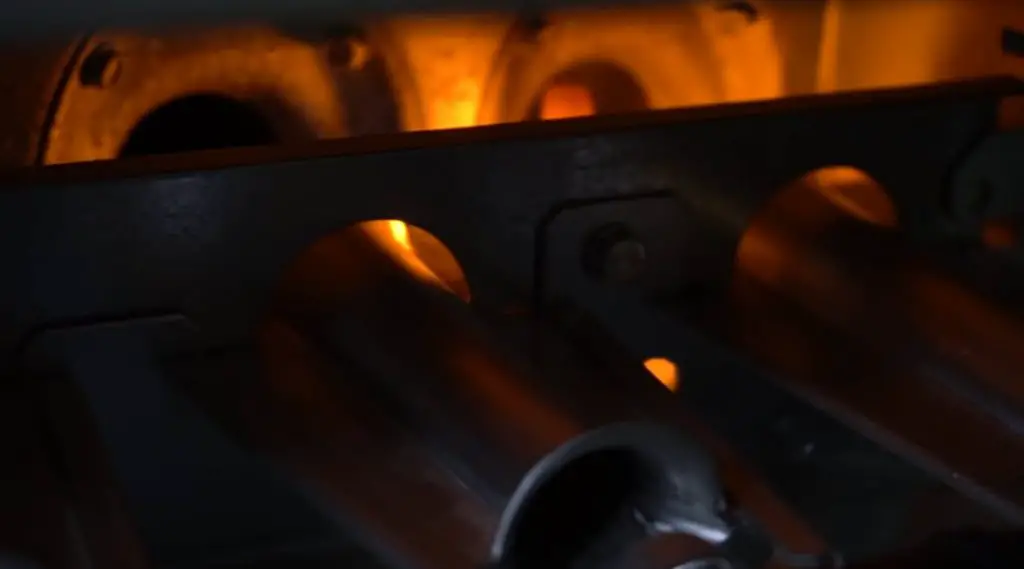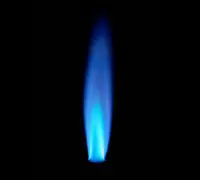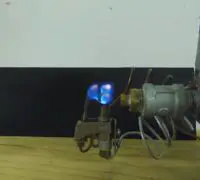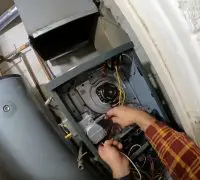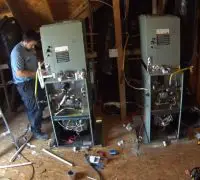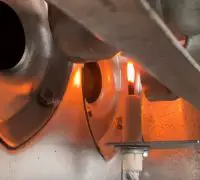Furnaces that run on natural gas or propane have an electronic igniter that continuously burns and ignites only when the furnace’s controls send fuel to the burners. Unlike other kinds of ignition systems (standard ignition is one), the electronic ignition system is less complex and easier to understand.
Page Table of Contents
How does the electronic ignition work?
When the ignition switch is turned on, it will run the moment the motor starts. The battery will give electricity as the positive terminal is connected to the ignition switch and the negative terminal is grounded.
The ignition coil features two windings (primary and secondary). The primary winding is thicker than the second one and both windings have insulation. An iron rod between the two windings helps create a magnetic field.
The magnetic pickup will occur when the armature rotates and couples with the electrical module. The voltage signal will appear when the magnetic pickup and armature get in contact. It will keep on generating until a powerful voltage signal occurs.
The voltage will get to the distributor with distributor points adjusted according to the ignition timing and the revolving rotator. The rotor passes in front of the distributor points, making the voltage jump through the air gap. This air gap goes from the rotor to the distributor.
A high-tension cable will take it to the spark plug terminal. Due to the spark at the spark plug’s tip, the spark will occur. It happens because of the voltage differential between the ground and center electrodes.
What steps to take to light a gas furnace with electronic ignition?
If you have a furnace with a pilot light, even a moderate breeze can make the pilot light go out and leave you with no heat. Luckily for homeowners, starting a furnace pilot light is not complicated.
Pilot lights on old furnaces can be lit every time they go out. It’s not the same with new gas furnaces, as the electrical ignition isn’t similar to pilot lights. With such models, you no longer have the manual lighting option. Specific steps will need to be made.
1. Set the thermostat to the lowest mode
Begin by taking a look at the thermostat. See that you set it to the lowest setting. It’s essential to take this step as it makes the furnace gradually go back to regular operation later.
2. Turn the furnace off
After you finish the thermostat, you should turn the furnace off. It’s not enough to turn off the furnace as it’s preferable to shut it off completely. It’s because it uses both gas and electricity. Look for the circuit switch on the furnace and flip it off. If you cannot find the circuit switch for the furnace, you can turn off the primary circuit.
3. Remove the burner door
Find the burner door. Typically, furnaces with electronic ignition have burner doors that are not placed in the exact location as in models with pilot lights. It can take a while until you find the doors. Check out the furnace’s base and look for the burner door. Get the user manual to see directions if you cannot find the burner door. Once you find it, you must place it aside before continuing.
4. Turn Off The Igniter
After you remove the burner door, you can turn off the igniter. Check out the user manual again to turn off the igniter. You might find the igniter as the control knob with marks “On,” “Off,” and “Pilot.” You need to turn the knob to the “Off” position.
Wait for at least five minutes. It would help if you did so to reduce the fire risk; it takes time until gas disperses. As you wait, look for the reset button, typically close to the dial you just set to “Off.”
5. Re-Light The Igniter
Once the waiting time is over, you should turn the knob to “Pilot.” Ideally, the gas has dispersed. Hold the button and bring the flame of the long lighter up close to the pilot light opening. Again, it would help if you waited for some time. Let go of the pressure on the pilot and check out if the pilot is burning. Continue with turning the knob to “On.”
6. Put the burner door back in its place
You can put the burner door back in its place. Do it carefully and install it properly. If you don’t do it properly, you can cause damage and alter the furnace’s performance.
7. Turn the gas furnace with electronic ignition back on
You’re now close to using the furnace. Giving power to the furnace will come next, so you have to turn on the furnace and send gas and electricity to the furnace. Don’t forget to adjust the thermostat and set it to the desired temperature. Take a leak at the pilot light; it should be lit.
If this is the first time you need to light your gas furnace, it’s not a bad idea to ask someone to do it first. Ask a friend or call a certified HVAC technician for assistance.
What can you do when the pilot light doesn’t light?
Sometimes, even if you go through the mentioned steps, you might not get successful and the thermostat might not start running. Here are some fixes to try.
Do it again!
If following the steps doesn’t light the gas, you can try to do it all over again. Maybe you haven’t done something right the first time. Don’t worry about restarting the pilot light. You won’t cause damage to the gas furnace if you do it again.
Verify the gas level
You must check the gas levels to see if the pilot light is weak and doesn’t burn continuously. The furnace’s gas reservoir might not be complete. Using the supply tank’s pressure gauge, you can quickly check out the gas level.
Clean dirty air filters and burners
Dirt across the burners might shut off the oxygen that the burners need to light. Cleaning is mandatory. It’s the same for the air filters in the furnace. When they’re dirty, they won’t be able to perform correctly.
Look at the air filters when you check out the gas furnace. Dirty air filters could stop the gas furnace from lighting.
Tighten or replace the thermocouple
The thermocouple might be damaged or loose when the pilot light doesn’t stay lit. You need to tighten the thermocouple or even replace it.
Regulate any draft
Sometimes a draft can impede the pilot light from staying lit. You should try re-light the pilot light, but wait for a while. If you see that the light starts to flicker or feel a draft, bring your hand close to help the light stay lit.
Replace the worn-out igniter/flame sensor
When the gas furnace doesn’t light, its igniter might be worn out or outdated. Replacing the igniter is the best solution for the furnace problem.
Clean the igniter/sensor
When the gas furnace’s igniter doesn’t perform as it should, it might be covered in dirt. You cannot clean the igniter before you turn off the furnace. Flip the switch on the furnace or turn off the electricity at the breaker box. Examine the igniter (a metal rod with a wire connected to the burner’s path).
Remove the igniter by unscrewing it and withdrawing the wire. You can clean the igniter’s surface with sandpaper or steel wool. Put back in its place the clean igniter. If this is the first time you need to clean it, you may ask for help from professionals or experienced friends. When you don’t clean it properly, you risk damaging the igniter. Stay safe and contact an HVAC technician to check out and clean the igniter.
One last piece of advice
If the gas furnace doesn’t light, you should call the professionals for service. Whether it’s igniter cleaning, replacement, or something else that needs to be done, they will do a far better job than you—no matter how many tutorials you watch on youtube.
